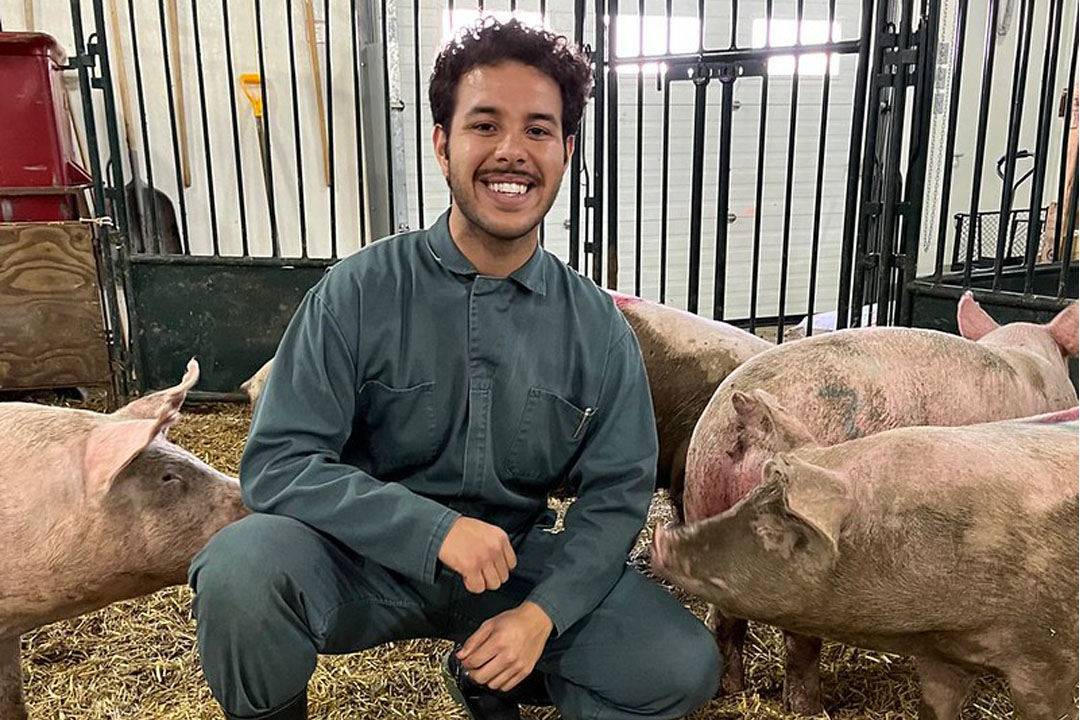
USask research team’s discovery breaks new ground in swine disease management
A University of Saskatchewan (USask) research team has discovered a bacteria-killing molecule that enhances a pig’s immune system response and could transform how swine producers treat and prevent contagious diseases in their animals.
USask researchers recently published a paper in Scientific Reports that identified a promising alternative for controlling infectious diseases such as swine dysentery. Porcine β-defensin 5, or pBD-5, is a host defence peptide (HDP) that may help to reduce the industry’s reliance on antibiotics.
Also known as antimicrobial peptides, HDPs are naturally occurring, innate immune molecules found in all complex living organisms. The antimicrobial properties of HDPs allow them to play a vital role in combating pathogens such as bacteria and viruses.
“As researchers, we have an important role and responsibility in advancing animal welfare. I’m very excited to work on this novel project knowing that the disease responses of pigs can be enhanced through exploring the properties of this new molecule,” said Dr. Arthur Nery Finatto (DVM), a PhD student based at the Western College of Veterinary Medicine (WCVM) and the research paper’s lead author. His supervisor is Dr. Matheus Costa (DVM, PhD), a WCVM associate professor and a board-certified veterinary practitioner in swine health management.
Caused by the bacterium Brachyspira hyodysenteriae, swine dysentery is a production-limiting disease that leads to significant economic losses for swine producers. There’s no effective vaccine for the infectious disease, and the only treatment option is antibiotic drugs.
Finatto said pBD-5 holds promise as an alternative to traditional antibiotic treatments—an important factor in global efforts to address the growing threats of antimicrobial resistance and food security for the world’s increasing population.
“We currently need antibiotics for animal welfare reasons—we cannot let the animals suffer from treatable diseases,” said Finatto. “But the development of this novel molecule is important because it is naturally produced by the pig. We can selectively breed animals that produce more of this protein—essentially creating pigs with stronger innate immunity.”
The team’s discovery was inspired by their observations of how some pigs developed severe clinical signs of swine dysentery while others in the same herd remained relatively unaffected by the disease.
Through detailed genomic analysis, the researchers identified a region of the swine genome associated with this resilience, which encoded a peptide resembling β-defensins, a family of host defence molecules known for their antimicrobial properties.
Building on this discovery, Finatto and the team synthesized the peptide in the lab. USask researchers completed this challenging task in collaboration with chemistry scientists at the Université du Québec à Montréal. When the researchers exposed pBD-5 to various bacterial strains, the synthesized peptide demonstrated broad-spectrum antimicrobial activity—effectively inhibiting bacterial growth.
“What was really exciting was that when we exposed pig immune cells to pBD-5, we saw changes in gene expression,” added Finatto. “The pig’s own immune system began to express different immune-related genes, which suggests that pBD-5 not only has antimicrobial properties but also acts as an immunomodulator.”
As well, the researchers observed that pBD-5 caused downregulation (a reduction of response) of certain genes in macrophages—immune cells that play a central role in the inflammatory response. By modulating the immune response, pBD-5 could help reduce the damage caused by swine dysentery and other production-limiting diseases.
In addition, pBD-5 appeared to enhance the activity of mitochondria in immune cells, particularly in cells responsible for antibody production. This finding suggests that adding pBD-5 to vaccine formulations could improve their ability to produce antibodies and to provide strong, long-term immunity to pigs.
Finatto hopes the research will help strengthen Canada’s swine industry.
“At the end of the day, our goal is to make pigs healthier and provide the population with high-quality pork, and I’m proud to contribute to this important responsibility.”
The Natural Sciences and Engineering Research Council of Canada (NSERC), le Centre de Recherche en Infectiologie Porcine et Avicole, and the Government of Saskatchewan funded this research.

